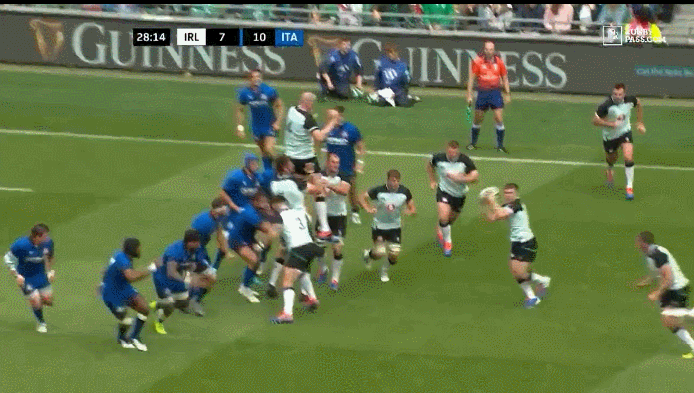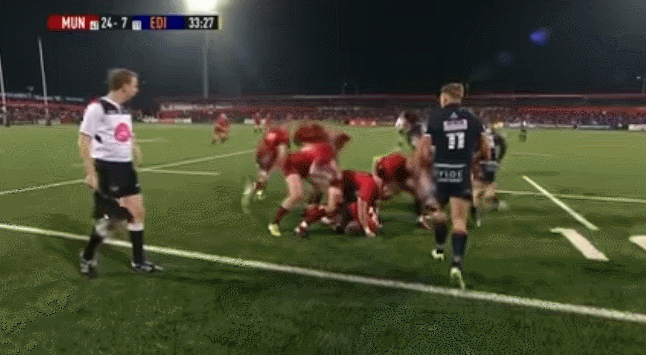There wasn’t an awful lot to get excited by during Ireland’s first Rugby World Cup warm-up match against Italy on Saturday but Munster centre Chris Farrell was certainly a highlight at Lansdowne Road.
After spending the majority of the year at outside centre, Farrell started inside Leinster centre Garry Ringrose against the Italians and combined brilliantly with fly-half Joey Carbery during a reasonably comfortable 29-10 win.
He ran hard and straight, he came out of the line quickly and made his tackles and he showed soft hands when needed, especially in the build up to Carbery’s first-half try.
Farrell’s biggest problem for Ireland has generally been the talent around him. Ever since Bundee Aki declared for Ireland in late 2017, it’s virtually been a three horse race between the New Zealander, Ringrose and Robbie Henshaw for a place in the Irish midfield.
Aki’s robustness in attack and prowess in defence makes him a relatively straightforward pick for Ireland coach Joe Schmidt at 12. There have been times where Robbie Henshaw has looked like the best player in Irish Rugby over the last two seasons and other times where you wonder if he’ll even make the pitch given his horrific luck with injuries.
As for Ringrose, he’s the most dynamic centre in Ireland. He had a relatively quiet game against Italy but an early linebreak at the start of the second-half quickly reminded those in attendance just what he is capable of doing when he has ball in hand.
Dislodging any of the aforementioned trio is an unenviable task for Chris Farrell. It’s hard enough choosing two from three for Schmidt in the centres but on the basis of yesterday’s performance, as well as his strong season with Munster, coupled with last year’s man of the match display against Wales in the Six Nations, you can make the argument that Farrell should work his way into starting contention and not just be relied upon as the emergency fallback option.
We’ll start with his defence.
Chris Farrell 👊
Enhanced his RWC chances more than any other Irish player today, IMO. pic.twitter.com/1FLR2Qnea0
— Cian Tracey (@CianTracey1) August 10, 2019
From the outset of Saturday’s game Farrell did a great job at getting off the line and shutting down Italian attacks before they even had the chance to develop.
Farrell made six tackles on the day – the second most of any Irish back – and at 6 ft 4 he has the size and frame to deliver some forceful hits in the middle of the pitch.
On the other side of the ball, and a lot like Aki, Farrell can be an effective crash ball runner and his hard straight running worked brilliantly off the line-out in the lead up to Dave Kearney’s try before the half hour mark.

Direct running is obviously a real strength of Farrell’s game. At one point during the first-half he very nearly steamrolled his way through Ian McKinley and over the line from a five-metre scrum only to fall inches short of the chalk.
Farrell can be blunt when needed but he also has the ability to show very soft hands and his pass to Carbery for his first-half try was a perfect example of his delicate touch.
Chris Farrell with the silky-smooth handling and Carbery does the rest 🔥🔥pic.twitter.com/OnXcfVlYOg
— SportsJOE (@SportsJOEdotie) August 10, 2019
It’s an area of his game that Schmidt has noticed for some time now and a facet he highlighted as a strength before including him in Ireland’s Six Nations match with Wales last year.
“He kind of found his feet a bit against Fiji, he was really good against Argentina and I think he showed there’s a bit more to Chris Farrell than a bludgeon – nice soft skills and a tight pass, he’s got a good length in his pass,” said Schmidt.
“He’s actually got pretty good kicking skills and I thought his defensive acumen on the day against Argentina… he closed the space down really well.
“They’d be probably some of the things that we’d volunteer as the strengths we see with Chris.”
Farrell can deliver the ball to teammates as a link or as a first receiver but he’s also capable at drawing in defenders and releasing the ball just before contact.

Here against Edinburgh last season we can see a really well worked move from Munster where Farrell creates the overlap by drawing in two defenders and feeding the ball out the back to J.J. Hanrahan, who picks out Mike Haley who then puts Andrew Conway away in the corner.
In the same game we can again see Farrell deliver a nice pass to Haley after Munster do an excellent job at realigning on the short side.

Munster number up well, Juan Pablo Socino rushes out of the line and is swatted away by Farrell who accelerates through the gap and draws the full-back in before composing himself and giving the ball to Haley who finds Earls from there.
Farrell has shown for both club and country that he can play direct when needed, that he can make forceful hits that prevent the opposition from getting over the gainline and that he has much better hands than what may be expected for a centre of his size and frame.
Ireland struggled for creativity at times during the Six Nations with the second fewest metres made and the second fewest clean breaks made despite having the most carries of any team in the tournament.
Farrell may help improve both areas if selected. The difficult question for Schmidt has always been who to play in the middle when Ringrose, Aki and Henshaw are all fit and healthy.
Farrell hasn’t made that process any easier.





































